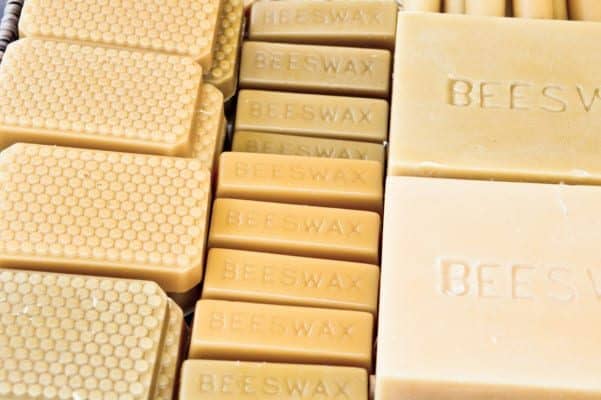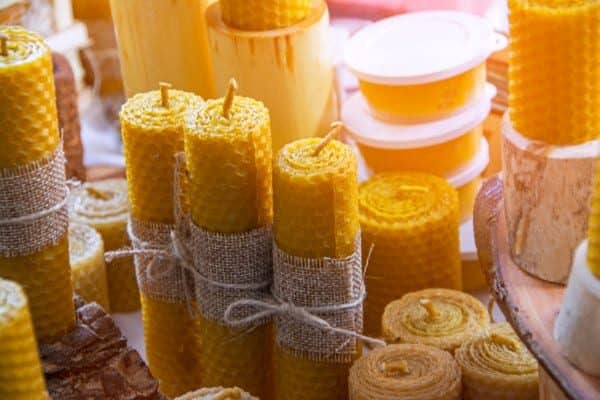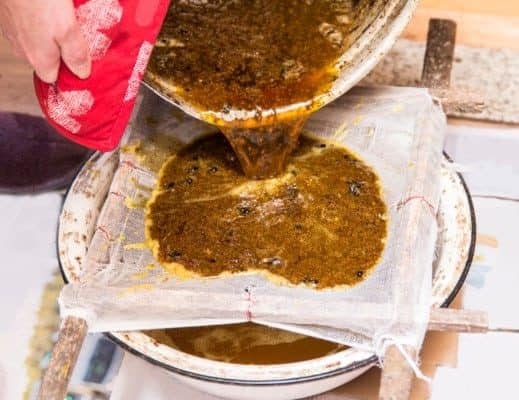One of the most invaluable qualities of honey, and its by-products, is the remarkably long shelf life it poses.
Take beeswax, for example, the versatile by-product of honey that can be found in everything from your average lip balm to plastic-free food storage. It’s all-natural and yet is virtually impossible to go bad.

So can beeswax go bad? Pure beeswax just like honey has an incredibly long shelf-life and it can never go bad. Beeswax contains propolis, a natural protective substance that shields it from going bad. Propolis is made by bees combining tree resin with wax flakes and pollen. It is used to strengthen, fix, and protect the hive with an antiseptic barrier.
What is Beeswax: Benefits, Uses, and Shelf Life?
Beeswax is made from the honeycomb of the worker bees. To produce the wax, honey bees eat honey and pollen. It takes around eight pounds of honey to produce one pound of beeswax. The wax is initially glass-clear, but after mixing the pollen oil into the honeycomb it becomes opaque and golden yellow in color.
Beeswax Benefits
Being all-natural and a byproduct of honey, beeswax has antibacterial properties and helps keep things clean as well as reduces risks of contamination. Beeswax also has antifungal properties preventing the growth of yeasts and other fungi.
We all know honey is super tasty. Have you ever tried eating honey that is still in the honeycomb? We have written an article on that very topic. The article is called, Can You Eat Honeycomb?
Practical Uses of Beeswax
This all-natural byproduct of honey has a number of health benefits and a myriad of uses. Even our prehistoric ancestors were aware of this fact, as several archeological findings show that beeswax has been used since prehistory as the first plastic, as a lubricant and waterproofing agent, as a polish for wood and leather, candle-making, and as an ingredient in cosmetics.
Woodworking
Beeswax is particularly popular when it comes to woodworking and is often used as a wood finish as well as a polish.
Candle Making
Beeswax is extremely popular in candle making and should you choose to produce your own candles you may have an additional revenue stream from your beekeeping activities.

Tool Maintenance
Beeswax can be used to prevent your tools from rusting by simply rubbing a bar of beeswax on the metal parts and then buffing off any excess material with a clean cloth. When combined with turpentine the mixture can be used to make bronze items regain their shine and sparkle. All you need to do is buff the area with a clean cloth.
When can beeswax go bad?
Commercial or homemade beeswax products can indeed go bad as they also include other ingredients. So, in instances where your beeswax is spoiling it means that you do not have a pure batch and it has most likely been mixed, or contaminated, with other substances. Due to the unregulated nature of the bee industry, ‘cutting’ of pure beeswax by adding other additives to it is not an uncommon practice
Other causes of beeswax going bad can include:
Pesticide
The use of pesticides can cause widespread exposure to bees which will ultimately result in the beeswax containing some form of pesticide. Exposure to pesticides will not only result in the beeswax being contaminated but it also has long-reaching side-effects to the bees as well as to general human health and well-being.
Hand Pollination
Some farmers may choose to “hand pollinate” their crops as a means to speed up the production of beeswax.
What this means is that they feed their honey bees sugar water instead of allowing them to forage and pollinate naturally. This will result in poor quality beeswax and it will also compromise the quality of life of the bees.
Improper Cleaning and Filtration
If the beeswax has not been cleaned and filtered by the correct methods then there is a strong chance contaminants will be left behind.

Premature Harvesting
Harvesting honey prematurely is a controversial beekeeping practice that is frowned upon but occurs nevertheless.
Generally speaking, beekeepers do not harvest their honey until it has a moisture level of 18.6% or less. This is the world-wide standard for what is considered to be ‘honey’.
Despite this, some beekeepers harvest their honey with moisture levels of 30-40%. Once harvested with moisture levels this high, beekeepers will use processors to vacuum any excess moisture until it reaches the desired 18.6% moisture level.
This results in bitter-tasting honey being produced and in some cases, there have been instances of lead contamination as a result of this.
We do have an entire article about what can cause honey to go bad. If you are interested the article is called, Does Honey Expire?
How To Get Pure Beeswax
To ensure you are getting pure beeswax of decent quality, there are several factors you should take into account when purchasing from a new supplier for the first time.
Below we take a closer look at these elements so that you can be in a better position to make an informed decision.
Source of Beeswax
Of course, when buying beeswax it is important to know where the beeswax originated from.
For instance, was it imported or is it local beeswax? Location and environment play a major role in the quality of the wax.
In some countries, like Brazil, for instance, it has been found that beeswax can get contaminated by pesticides as pesticide regulations are not as strong.
This is something you will want to bear in mind. Therefore, it will be wise to ask your supplier where they got the beeswax, as that information can determine the quality and the shelf life of the product.
How Was the Beeswax Cleaned and Filtered?
We briefly touched on the importance of properly cleaned and filtered beeswax earlier in this article and how this affects the general quality and shelf-life of beeswax.
Ensure you are getting beeswax that has been thoroughly cleaned and undergone multiple filtration cycles. Ideally, your beeswax should be thoroughly cleaned to food-grade quality and you should accept nothing less than this.
What Additives Does the Beeswax Contain?
As mentioned earlier, some beekeepers may attempt to maximize their profits through unscrupulous practice methods such as cutting the beeswax with an additive. If sourcing beeswax from elsewhere make sure to ask difficult questions like this so as to ensure you’re actually getting 100% pure beeswax and not an adulterated product.
Ask for a Sample
This seems like a no-brainer but usually, the most common solutions are overlooked. Whether you are buying from your regular supplier or a new source. You should always ask for a sample to verify the authenticity of the product.
Once you get the sample, do a little investigation by inspecting the color and the scent of the product. Pure beeswax has an indistinct honey smell to it, so any different scent gives away that the product has been cut with another substance.
For example, if the beeswax has a crayon smell to it that means that it has probably been cut with paraffin.
You can also check the texture of the sample to ascertain the purity. Beeswax that has been cut tends to be excessively waxy and also quite flaky. Furthermore, beeswax that has been cut will break smoothly when you try to break it in half.
How To Store Beeswax
Although beeswax will generally never go bad, there are several measures you can take during the storage period to ensure that there are no external factors that may cause contamination or ruin the beeswax in general.
One of the most important factors to consider when storing your beeswax is the temperature of the environment that you store it in.
When kept in cooler temperatures beeswax forms a powdery substance on its surface called bloom.
Bloom does not take away from the quality of the beeswax and should not be a major cause for concern. In most cases the substance can easily be cleaned off the beeswax by using something as simple as a blow-dryer to blast the bloom away.
More often than not you can simply wrap your beeswax in plastic as a means to ensure no dust, fuzz, or unwanted contaminants touch your beeswax.
Given the pricey nature of beeswax, and the many applications available, keeping your wax in a good condition only plays out in your favor as you can sell the wax for profit or process it further to create a variety of products.
One thing to note when storing your beeswax in plastic is that sometimes it can stick to the plastic if it is stored somewhere too warm and begins to soften. Pure beeswax will remain solid at room temperature.
The Wrap Up
Pure beeswax never goes bad, that’s the bottom-line. If for some reason you acquire a batch that spoils with time this simply means it was contaminated and can no longer be considered as ‘pure’.
This guide will have provided you with the basic knowledge necessary to decipher pure beeswax from contaminated, or cut, beeswax.
Resources:
● Beeswax Harvest FAQ – Hive Harvest: http://hiveharvest.com/beeswax-facts-and-faqs/
● The Hidden Dangers of Imported Honey – The Beeswax Co: https://beeswaxco.com/wp-content/uploads/2018/06/The-Hidden-Dangers-of-Imported-Beeswax-1.pdf
● Beeswax: History, Uses, Trade – Stefan Bogdanov: https://www.researchgate.net/publication/304012171_Beeswax_History_Uses_Trade
● 10 Versatile Uses for Beeswax – Lawrence Journal World: https://www2.ljworld.com/news/2015/feb/01/fix-it-chick-10-versatile-uses-beeswax/
● 15 Surprising Uses of Beeswax – Pure Wow: https://www.purewow.com/home/uses-for-beeswax
● Does Honey Expire – Honey Bee HQ: https://whatbugisthat.com/does-honey-expire/
